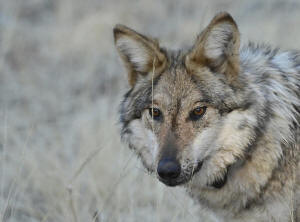Snatched pets and livestock deaths blamed on wolves raise alarms in
rural New Mexico
[April 03, 2025]
By SUSAN MONTOYA BRYAN
ALBUQUERQUE, N.M. (AP) — Commissioners in a rural New Mexico county say
pets are being snatched from front yards and livestock are being maimed
and killed by endangered Mexican gray wolves that seem to have no fear
of humans, prompting them to consider declaring a state of emergency.
In the latest flash point over efforts to reintroduce wolves into the
western U.S., the commissioners in Catron County are meeting Thursday to
consider a resolution that would make available funds to hire more
people to investigate the damage reports and help haze the wolves.
“This is an immediate health and safety hazard to individuals and
property,” Catron County commissioners said in a recent news release.
“Please be aware of your surroundings when outdoors at all times.
Maintain constant supervision of children and pets. Alert our elderly
citizens to take appropriate precautions.”
It’s not just an issue in rural New Mexico, as officials in parts of
Oregon and Northern California say the wolves seem brazen and more
livestock is turning up dead. Two California counties have declared
emergencies in recent weeks and the sheriff in another recently
requested the help of state wildlife officials.
Mexican wolves are the smallest subspecies of gray wolves. Ranchers have
been at odds with efforts to reintroduce these more rare gray wolves
since the late 1990s when the first captive ones were released into the
wild. They have argued that despite meager programs for reimbursing
losses, the wolves pose a threat to their own way of life, which is
already challenged by prolonged drought and rising prices.

Environmentalists argue that Mexican gray wolves should have a place in
the Southwest, often criticizing the U.S. Fish and Wildlife Service for
not releasing more captive wolves to ensure genetic diversity among the
wild population. They contend there’s no incident in recorded history of
a Mexican wolf attacking or injuring a person.
The latest survey of Mexican gray wolves showed there were at least 286
in Arizona and New Mexico, marking the ninth straight year of population
growth. The wolf recovery team also reported 99 confirmed livestock
kills in 2024, saying that number has been decreasing in recent years.
Wildlife managers conducted 290 successful hazing operations last year
to scare wolves away from rural homes and livestock.
In the proposed resolution, Catron County states that the culture and
customs of residents have been compromised by the wolf reintroduction
program. It would request emergency financial aid from the state and
asks for the governor to order into service the New Mexico National
Guard to support county authorities as needed.
[to top of second column]
|

This Jan. 24, 2025 file image provided by the Arizona Game and Fish
Department shows a Mexican gray wolf in the wild that was monitored
as part of a population survey in eastern Arizona. (Arizona Game and
Fish Department via AP File)

In Oregon, ranchers in Lake County — home to some of that state’s
largest cattle operations — said they were forced to hire extra
workers to patrol their herds around the clock. Some bought night
vision goggles to help with the task. That county commission
declared a public safety and livestock emergency in February and
asked the governor there to help with removing a collared wolf
thought to be behind several livestock kills. Wildlife managers
ended up killing the wolf after nonlethal efforts failed.
In California, Sierra County declared an emergency on Tuesday,
following similar action by Modoc County in mid-March. Neighboring
Lassen County also has reported increased wolf activity.
And in Colorado, a group of citizens is gathering petition
signatures in hopes of putting the question of wolf reintroductions
to voters through a ballot initiative in 2026. Federal wildlife
managers in Colorado just recently killed a collared wolf that
appeared to have crossed the state line into Wyoming and killed
several sheep.
In Montana, lawmakers are considering legislation to extend the wolf
hunting season, while state wildlife managers in Idaho allow for
limited wolf trapping and snaring as a way to manage the population
there.
Gray wolves in the Northern Rockies and beyond have been another
source of lawsuits over the years. And those for and against the
reintroduction strategy have been waging legal battles with the
federal government for decades over the wolves roaming parts of
Arizona and New Mexico, with the fate of a management rule and the
boundaries of the recovery area pending before a federal appeals
court.
All contents © copyright 2025 Associated Press. All rights reserved
 |